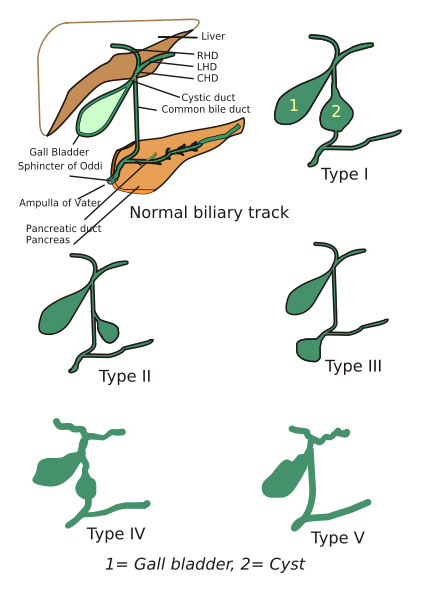Choledochal cysts
Editor-In-Chief: C. Michael Gibson, M.S., M.D. [1]
Please Take Over This Page and Apply to be Editor-In-Chief for this topic: There can be one or more than one Editor-In-Chief. You may also apply to be an Associate Editor-In-Chief of one of the subtopics below. Please mail us [2] to indicate your interest in serving either as an Editor-In-Chief of the entire topic or as an Associate Editor-In-Chief for a subtopic. Please be sure to attach your CV and or biographical sketch.
Overview
| Choledochal cysts | |
| ICD-10 | Q44.4 |
|---|---|
| ICD-9 | 751.69 |
| DiseasesDB | 2527 |
| eMedicine | med/349 |
| MeSH | D015529 |
Template:Search infobox Choledochal cysts are congenital conditions associated with benign cystic dilatation of bile ducts. They are uncommon in western countries[1] but not as rare in East Asian nations like Japan and China.
Genetics
Choledochal cysts may be associated with Caroli disease.
Classification scheme
Choledochal cysts were classified into 5 types by Todani in 1977[2].

Classification was based on site of the cyst or dilatation. Type I to IV has been subtyped.
- Type I: Most common variety involving saccular or fusiform dilatation of a portion or entire common bile duct (CBD) with normal intrahepatic duct.
- Type II: Isolated diverticulum protruding from the CBD.
- Type III or Choledochocele: Arise from dilatation of duodenal portion of CBD or where pancreatic duct meets.
- Type IV: Dilatation of both intrahepatic and extrahepatic biliary duct.
- Type V or Caroli's disease: Cystic dilatation of intra hepatic biliary ducts.
Signs and Symptoms
Most of them present in 1st year of life; adult presentation is rare and usually at this stage is associated with complication . Classic triad of intermittent abdominal pain, jaundice, and a right upper quadrant abdominal mass is found only in minority of patients. A hepatic cyst may be present, as may short stature. A fever of unknown origin may be observed. Pancreatitis may be present.
Treatments
Choledochal cysts are treated by surgical excision of the cyst with the formation of a roux-en-Y anastamosis to the biliary duct.
Future complications include cholangitis and a 2% risk of malignancy, which may develop in any part of the biliary tree.
References
- ↑ Liu YB, Wang JW, Devkota KR; et al. (2007). "Congenital choledochal cysts in adults: twenty-five-year experience". Chin. Med. J. 120 (16): 1404–7. PMID 17825168.
- ↑ Todani T, Watanabe Y, Narusue M, Tabuchi K, Okajima K (1977). "Congenital bile duct cysts: Classification, operative procedures, and review of thirty-seven cases including cancer arising from choledochal cyst". Am. J. Surg. 134 (2): 263–9. PMID 889044.
Template:SIB Template:Cystic diseases Template:Congenital malformations and deformations of digestive system